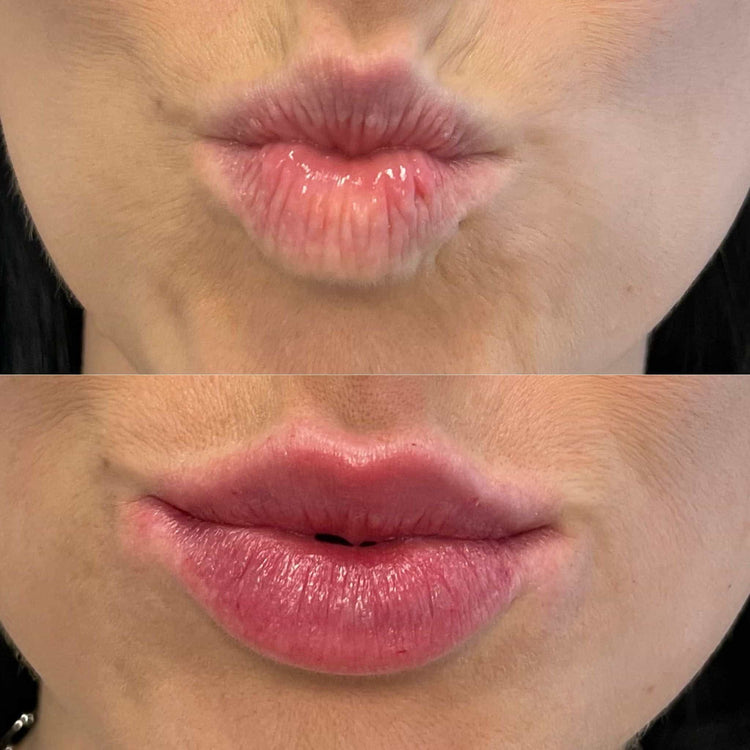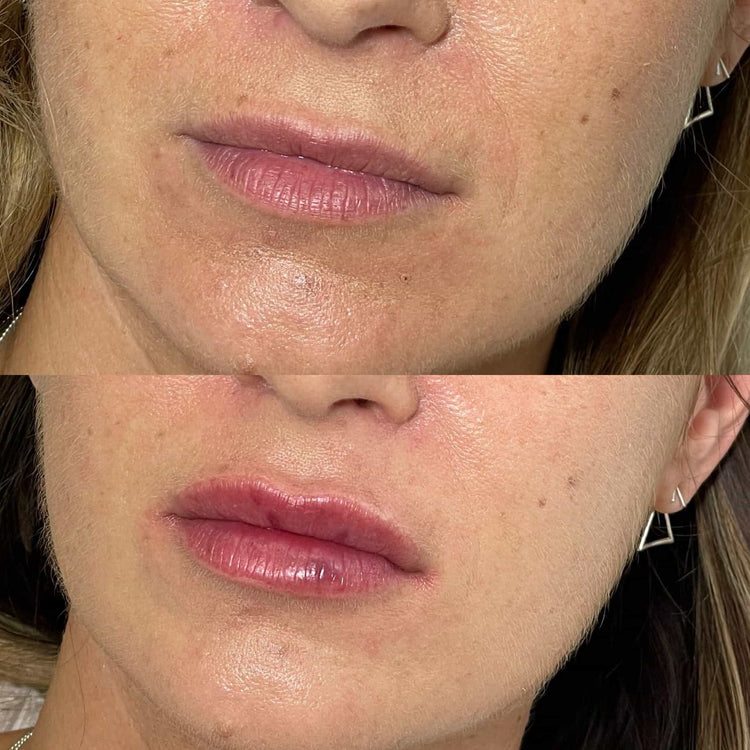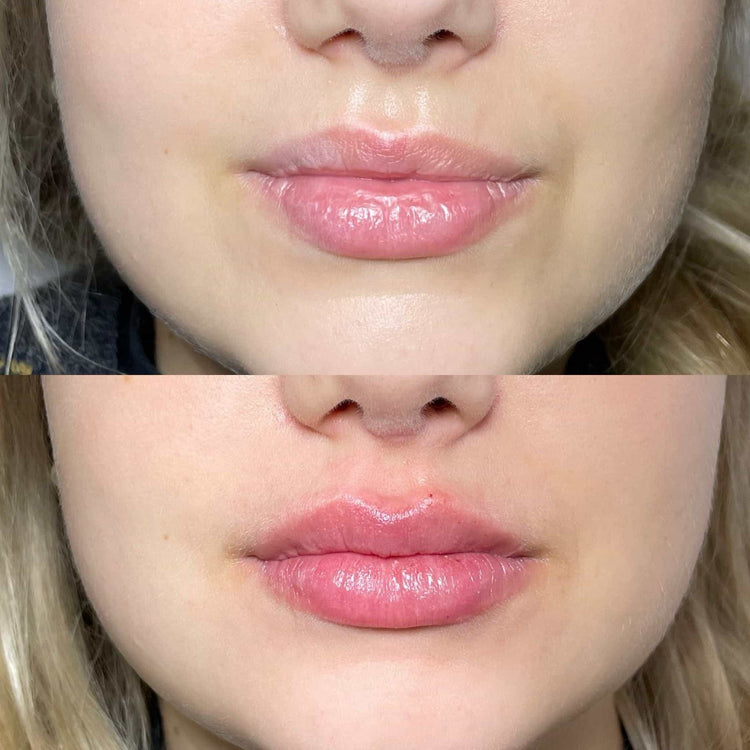How it Works
Many individuals desire fuller lips, and dermal fillers are often used to achieve this aesthetic goal. However, sometimes filler injections can result in an overly plump or unnatural appearance. Fortunately, there are methods to correct overfilled lips, one of which is filler dissolving treatment.
Dissolving Enzymes
Filler dissolving treatment is a procedure used to address the issue of overfilled lips caused by excessive dermal filler injection. It involves the use of a special enzyme called hyaluronidase, which breaks down hyaluronic acid, the main ingredient in many popular fillers.
- Hyaluronic acid is a natural substance found in the body that helps to retain moisture and add volume to tissues.
- When injected as a filler, it plumps up the lips, but if too much is used, it can create an unnatural or overly inflated appearance.
Hyaluronidase works by targeting and breaking down the hyaluronic acid bonds in the filler, gradually dissolving the gel. The treatment is typically administered as a series of injections directly into the area where the excess filler is located. After the enzyme has worked its magic, the dissolved filler is naturally absorbed by the body.
Procedure
Filler dissolving treatment effectively addresses overfilled lips caused by excessive dermal filler injections. The procedure utilizes hyaluronidase, an enzyme that specifically breaks down hyaluronic acid, the primary component of many popular fillers.
Hyaluronidase works by targeting and disrupting the bonds within the hyaluronic acid molecules, causing the filler gel to gradually dissolve. This process is typically carried out through a series of injections directly into the areas where the excess filler is present. Once the hyaluronidase has completed its task, the dissolved filler is naturally absorbed by the body.
Benefits of Filler Dissolving Treatment
Overfilled lips are a common concern for individuals who have undergone dermal filler treatments. Fortunately, a safe and effective solution exists: filler dissolving treatment. This procedure utilizes a specialized enzyme called hyaluronidase to reverse the effects of excessive hyaluronic acid fillers, restoring a more natural lip appearance.
Correction of Overfilled Lips
Filler dissolving treatment is a valuable option for correcting overfilled lips.
It works by utilizing an enzyme called hyaluronidase which specifically targets and breaks down hyaluronic acid, the common ingredient in many dermal fillers.
This process gradually dissolves the excess filler, allowing it to be naturally absorbed by the body.
The result is a reduction in lip volume, restoring a more natural and balanced appearance.
Minimally Invasive
Filler dissolving treatment offers numerous benefits for individuals seeking to correct overfilled lips. Firstly, it provides a minimally invasive solution compared to surgical interventions. The procedure involves simple injections, minimizing discomfort and downtime.
Secondly, filler dissolving treatment is highly effective in reversing the effects of excess hyaluronic acid fillers. Hyaluronidase, the enzyme used in this treatment, specifically targets and breaks down hyaluronic acid, gradually dissolving the filler and restoring a more natural lip shape.
Another benefit is its reversibility. Unlike permanent fillers, hyaluronic acid fillers can be dissolved, allowing for adjustments to achieve desired results. This flexibility makes it suitable for individuals who may want to modify their lip volume over time.
Less Downtime Compared to Revision Surgery
One of the most significant advantages of filler dissolving treatment is its reduced downtime compared to revision surgery. While surgical procedures often involve extensive recovery periods, filler dissolving treatment allows patients to return to their normal activities relatively quickly.
This minimally invasive approach minimizes discomfort and swelling, leading to a faster healing process.
Potential Risks and Side Effects
While filler dissolving treatment can effectively correct overfilled lips, it’s essential to be aware of potential risks and side effects. These may include bruising, swelling, redness, tenderness, or itching at the injection site. In rare cases, more serious complications like allergic reactions, infection, or uneven resorption of the filler can occur.
Temporary Swelling and Bruising
Temporary swelling and bruising are common side effects of filler dissolving treatment. These occurrences are typically mild and subside within a few days to a week after the procedure.
To minimize these side effects, it’s crucial to follow your practitioner’s post-treatment instructions carefully. This may include applying ice packs to reduce swelling, avoiding strenuous activities, and keeping the treated area clean.
Allergic Reactions
Potential risks and side effects associated with filler dissolving treatment include bruising, swelling, redness, tenderness, and itching at the injection site. These are usually mild and temporary.
More serious complications, such as allergic reactions, infection, or uneven resorption of the filler, are rare but possible.
It’s crucial to consult with a qualified and experienced practitioner to discuss your medical history and any potential risks before undergoing the procedure.

Following post-treatment instructions carefully can help minimize side effects and ensure optimal healing.
Uneven Dissolution
Potential risks and side effects associated with filler dissolving treatment include bruising, swelling, redness, tenderness, and itching at the injection site. These are usually mild and temporary.
More serious complications, such as allergic reactions, infection, or uneven resorption of the filler, are rare but possible. Uneven dissolution can lead to asymmetry in lip appearance.
It’s crucial to consult with a qualified and experienced practitioner to discuss your medical history and any potential risks before undergoing the procedure. Following post-treatment instructions carefully can help minimize side effects and ensure optimal healing.
Choosing a Qualified Practitioner
When considering any cosmetic procedure, choosing a qualified practitioner is paramount. For filler dissolving treatment, this becomes even more important as the process involves injections and requires expertise in understanding facial anatomy and filler properties.
Experience with Filler Dissolving Treatments
Choosing a qualified practitioner for filler dissolving treatment is crucial to ensure safety and achieve desired results. Look for a practitioner who is board-certified in plastic surgery or dermatology with extensive experience in administering dermal fillers and performing filler dissolving procedures.
Inquire about their qualifications, training, and track record of successful treatments.
It’s also essential to discuss your medical history, any allergies you may have, and your desired outcome during a consultation. This allows the practitioner to assess your suitability for the procedure and develop a personalized treatment plan.

Proper Training and Certification

Choosing a qualified practitioner is paramount when considering filler dissolving treatment. A skilled practitioner will have in-depth knowledge of facial anatomy and understand how different fillers behave.
Proper training and certification are essential to ensure safe and effective treatment. Look for practitioners who are board-certified in plastic surgery or dermatology, demonstrating their expertise and commitment to professional standards.
Aftercare Instructions
Aftercare instructions are crucial for ensuring optimal healing and minimizing potential complications after filler dissolving treatment.
Ice Packs and Elevation
Aftercare instructions provided by your practitioner will be specific to your situation, but generally include measures to minimize swelling, bruising, and discomfort.
Ice packs applied to the treated area for 15-20 minutes at a time, several times a day, can help reduce swelling.
Elevation of the head while sleeping can also aid in reducing fluid buildup.
Avoiding strenuous activities and excessive sun exposure is recommended during the healing period.
It’s essential to follow all post-treatment instructions carefully and contact your practitioner if you experience any unusual or concerning symptoms.
Avoid Touching or Rubbing Lips
Aftercare Instructions are crucial for ensuring optimal healing and minimizing potential complications after filler dissolving treatment.
Avoid touching or rubbing lips as this can irritate the treated area and delay healing.
Protecting Skin from Sun Exposure
Protecting your skin from sun exposure is essential, especially after any cosmetic procedure like filler dissolving treatment. Ultraviolet (UV) radiation from the sun can damage the skin and increase the risk of complications such as hyperpigmentation (darkening of the skin), scarring, and delayed healing.
During the initial healing phase after filler dissolving treatment, it’s crucial to diligently protect your skin from the sun. Avoid direct sun exposure for at least 2 weeks following the procedure.
When you do need to be outdoors, always apply a broad-spectrum sunscreen with an SPF of 30 or higher. Reapply every 2 hours, especially after sweating or swimming.
Consider wearing protective clothing like hats and sunglasses to provide additional shielding for your skin.
Be aware that even on cloudy days, UV radiation can penetrate the clouds.
Aftercare instructions provided by your practitioner may include specific recommendations regarding sun exposure. It’s crucial to follow these instructions carefully and ask any questions you may have about protecting your skin during the healing process.
- Demigender Identities And How They Redefine The Concept Of Gender In Love - May 1, 2025
- Can Filler Dissolving Treatment Correct Overfilled Lips - May 1, 2025
- Cheek Filler Near Leatherhead, Surrey - April 30, 2025